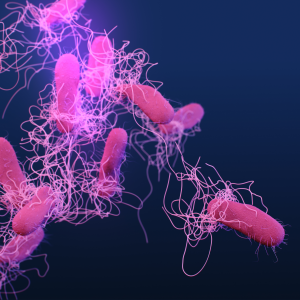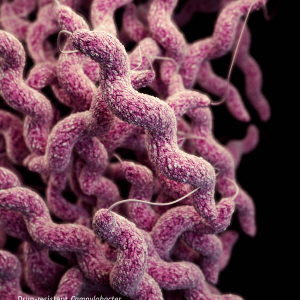Four consumer advocacy groups are urging the Agriculture Department to improve its regulations and enforcement procedures to prevent the continued contamination of poultry with salmonella and campylobacter, two of the most common causes of food-borne illness in the United States.
Currently, the USDA’s Food Safety and Inspection Service regulates the amounts of salmonella and campylobacter found in mostly randomly-selected poultry at production and distribution plants, warning companies with too-high rates of contamination and placing those companies’ names on a publicly accessible list.
But the consumer groups say current inspection practices are not effective and, as a result, aren’t making a dent in the number of people who are getting sick from contaminated poultry.
The Center for Science in the Public Interest, Consumer Reports, the Consumer Federation of America and STOP Foodborne Illness are proposing tighter, more targeted federal poultry regulation and inspection procedures.
“Outbreak data suggests that consumption of poultry meat represents the leading source of both salmonella and campylobacter illnesses,” the groups say in their petition. “Nevertheless, contamination remains high in many products…. Measures taken to date to control contamination in poultry products have yet to have a significant impact on human illness rates.”
Poultry inspections should focus on the most dangerous types of salmonella and campylobacter with the aim of eliminating them at production plants, the consumer organizations said. Violators should face more severe sanctions than simply having their names published on a public list, they said.
Poultry companies also should be held at least partially responsible for using any contaminated poultry, much like the Food and Drug Administration holds food companies partially responsible for their contaminated ingredients, according to the groups’ petition.
In addition, the groups want the USDA to have standard procedures for keeping live birds, as well as their housing, bedding, feed and water clear of contamination, including during transportation and slaughter.

Many of these measures are already common at American poultry farms, according to veterinarian and CSPI Food Safety Campaign Manager James Kincheloe. He added that most of the other changes could be accomplished with microbial testing of birds before and after they are slaughtered.
Rather than instituting grandiose, expensive changes, Kincheloe explained, the changes mentioned in the petition would mean an increase in tests that are already normal parts of the poultry production process.
Both salmonella and campylobacter are families of bacteria that can cause human illness. They are often transmitted in food products, particularly poultry.
Humans most commonly get salmonella from contaminated food, contaminated water and interacting with live animals, according to the Centers for Disease Control and Prevention.
Symptoms of salmonella poisoning generally begin between six hours and six days of infection, and may last between four and seven days. Symptoms may include bloody diarrhea, stomach cramps, fever, nausea, vomiting and headaches. In extreme cases, salmonella can spread to the bloodstream, with sometimes fatal results.
Campylobacter, like salmonella, is often spread to humans through foods of all types, unclean water and live animals. Victims experience illness similar to that caused by salmonella. But campylobacter infections also may result in some daunting complications, including irritable bowel syndrome, temporary paralysis and arthritis.
Campylobacter infection also has the dubious honor of being the most commonly identified cause of Guillan-Barré syndrome, an autoimmune disorder that attacks the nervous system, causing muscle weakness, paralysis and sometimes death. Recovery can range from a few weeks to a few years.
While nearly every food – produce, dairy, meat – has the potential to spread salmonella and campylobacter infections, poultry remains at the top of the CDC’s list of common causes for outbreaks.
As consumer advocacy groups have continued to track these outbreaks in recent years, a pattern has emerged: only a very small group of the thousands of salmonella types are actually causing illnesses and deaths, according to Kincheloe.
“To us at CSPI and STOP and our other co-signatories, it makes sense to start to target those specific types of salmonella,” Kincheloe said. “The science is there. And that’s really the No. 1 driver of when we put in a petition like this… We have evidence to show that there are things we can do to target these specific types. So we feel that it’s time to take those actions.”
But the National Chicken Council, which represents chicken producers, processors, distributors and “allied industry firms” in the United States, opposes additional regulation.
“Chicken production is already one of the most heavily regulated industries in the United States,” said Dr. Ashley Peterson, the council’s senior vice president of scientific and regulatory affairs.
“Companies have invested tens of millions of dollars in technology and other scientifically-validated measures to enhance the safety profile of chicken products,” she said. “A science-based, multi-tiered approach aimed at reducing all pathogen strains on raw meat and poultry products results in a more appropriate and effective use of agency resources compared to a separate focus on specific, individual strains.”
But such well-established procedures are flawed, according to Michael Taylor, co-chair of STOP Foodborne Illness and former acting undersecretary for food safety at the USDA’s Food Safety and Inspection Service.
Salmonella and campylobacter continued to account for “over 70% of the illnesses transmitted commonly by food… sickening an estimated 1.9 million Americans each year,” Taylor wrote in a recent op-ed in Food Safety News.
In 2018, nearly 300 people fell ill due to food-borne campylobacter contamination in the United States, according to the CDC. Close to 4,800 people were similarly infected with food-borne salmonella, and more than 1,100 of those people were Maryland residents, two of whom died.
These numbers were higher than they’ve been since 1997, according to the CDC. And rates were visibly unimproved by the introduction of new performance standards for corporations in 2016, which placed a salmonella and campylobacter contamination limit on all raw poultry parts. Before 2016, the USDA only officially set salmonella and campylobacter limits for ground poultry meat.
Many consumer advocacy groups believe that this lack of improvement proves that the current regulations and procedures used by poultry companies and the USDA are not doing what they were intended to do.
In the 1990s, the safety of poultry and meat products still primarily relied on visual confirmation of sanitary standards; it was the beginning of any lab-style testing of poultry and meat products, although this type of inspection was done mostly at random.
Today, the presence of campylobacter can be detected in poultry before slaughter with microbial testing, much like how people are tested for infection. This testing is often done at random, occasionally in response to a visually problematic piece of meat.

In addition, the source of salmonella contamination in poultry can be traced to either pre-slaughter contamination or post-slaughter contamination of the meat.
This is because salmonella does not originate in poultry meat. It must be introduced from the outside: spread through live flocks, slaughterhouse contamination or from poultry intestines. Once contamination has been identified, there are only a handful of paths for an investigator to trace to find its origins.
“No one wants to reduce salmonella and campylobacter more than the companies producing our food,” Peterson said.
But she cautioned: “Raw chicken, just like any other raw agricultural commodity, is not a sterile product, and no regulation or law will ever make it sterile.”
“There is still the possibility of illness if a raw product is improperly handled or cooked,” Peterson said. “Proper handling and cooking of poultry is the one thing that will eliminate any risk of food-borne illness.”
Placing the onus of properly “cooking away” bacterial contaminants upon the consumer is not unusual. In a 1974 federal court decision, U.S. Circuit Judge Roger Robb wrote that “American housewives and cooks normally are not ignorant or stupid and their methods of preparing and cooking of food do not ordinarily result in salmonellosis.”
But that principle – besides the dated and sexist reference – leaves out consumers who believe that they are purchasing their food ready-made, such as from a restaurant, a very common vector for food-borne illness according to the CDC.
In one such instance, which took place throughout the end of 1992 and the beginning of 1993, over 500 people became ill due to E. coli-contaminated hamburger meat. All of the cases were traced to a restaurant chain in the state of Washington. This incident, sometimes called “the Jack in the Box outbreak” for the eponymous restaurant chain, was one of the incidents that led to the formation of STOP Foodborne Illness.
The consumer advocacy groups’ petition can be found in full under the “Petitions” section of the Food Safety and Inspection Service’s website, fsis.usda.gov.
USDA Food Safety and Inspection Service spokesman Buck McKay said his agency expects “a significant number of comments.”
The opportunity for public comments on the petition closes April 6.


You must be logged in to post a comment.